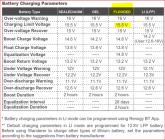Sillyputty
Solar Enthusiast
- Joined
- Jul 21, 2020
- Messages
- 188
Hi folks - I submitted a trouble ticket to Renogy, and the reply seems nonsensical to me, but what do I know? The gist is below - any suggestions are welcome.
Me:
"My new Renogy Wanderer PWM seems to exceed 15 Volts intermittently which (I think) causes inverter to shutdown due to over-voltage.
Otherwise, things function without any known issues.
Is this the 'equalization cycle' and if so, can the controller be programmed via Bluetooth to correct/lower the EQ voltage to ~ 14.9 Volts in order to not trigger the inverters protection?
Them:
"Based on your feedback, we have the following suggestions: The voltage is 15V, indicating that the battery is over-voltage, because your battery's maximum charging voltage is 14.8V, so it is judged that the battery may be faulty. It is recommended to replace the battery and retest."
Me: ¯\_(ツ)_/¯
Me:
"My new Renogy Wanderer PWM seems to exceed 15 Volts intermittently which (I think) causes inverter to shutdown due to over-voltage.
Otherwise, things function without any known issues.
Is this the 'equalization cycle' and if so, can the controller be programmed via Bluetooth to correct/lower the EQ voltage to ~ 14.9 Volts in order to not trigger the inverters protection?
Them:
"Based on your feedback, we have the following suggestions: The voltage is 15V, indicating that the battery is over-voltage, because your battery's maximum charging voltage is 14.8V, so it is judged that the battery may be faulty. It is recommended to replace the battery and retest."
Me: ¯\_(ツ)_/¯





